Class Aves
Order Passeriformes
Family Corvidae
Corvus sp.—Ravens and Relatives // Corvus brachyrhynchos—American Crow // Corvus caurinus—Northwestern Crow // Corvus corax—Common Raven // Corvus cryptoleucus—Chihuahuan Raven // Corvus neomexicanus—New Mexican Raven
Ravens and crows are relatively large passeriform birds noted for their intelligence. The Common Raven, the Chihuahuan Raven, and the American Crow all occur now in our region, though habitat and geographic preferences differ to a degree. A fourth species, the New Mexican Raven, now extinct, is recorded from the older deposits of Dry Cave and is intermediate in size to the Common Raven and the Chihuahuan Raven (Fig. 1; see also Fig. 1 of the C. corax account and Fig. 1 of the C. neomexicanus account).
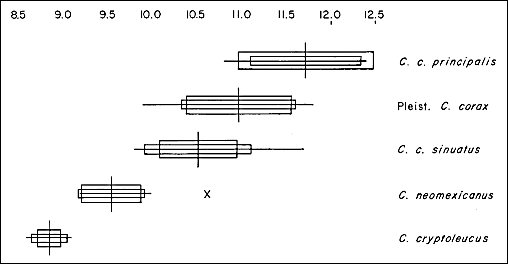
Fig. 1. Comparison of anterior width of tibiotarsus of five populations of Corvus. Vertical line indicates mean; horizontal line, observed range; large rectangle, 95% confidence interval for the mean; small rectangle, plus and minus one standard deviation. “x” marks the position of UTEP specimen 1-1033 (see C. corax account). After Magish and Harris 1976.
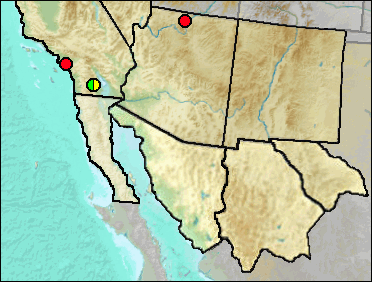
Sites.
Late Blancan/Irvingtonian: Anza-Borrego Desert (Jefferson 2006)
Sangamon: Newport Bay Mesa (Jefferson 1991a).
Mid/Late Wisconsin: Sandblast Cave (Emslie 1988).
Literature. Emslie 1988; Jefferson 1991a, 2006.
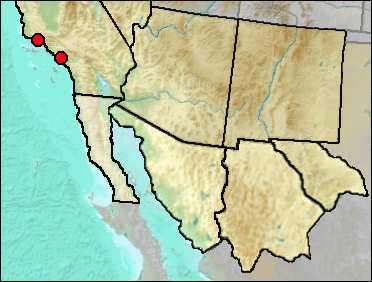
Present distribution is spotty in the border region, probably representing wandering individuals. However, resident populations occur in the northern parts of our region.
Sites.
Wisconsin: Carpinteria (Guthrie 2009).
Mid/Late Wisconsin: Rancho La Brea (Stock and Harris 1992).
Literature. Guthrie 2009; Stock and Harris 1992.
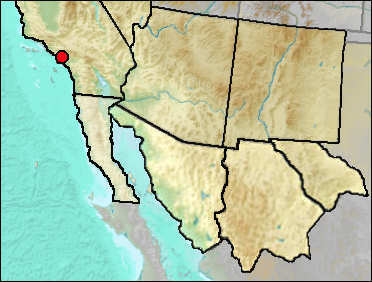
The Northwestern Crow currently occurs in coastal areas from near the Oregon border north to Alaska.
Sites.
Mid/Late Wisconsin: Rancho La Brea (Stock and Harris 1992).
Literature. Stock and Harris 1992.
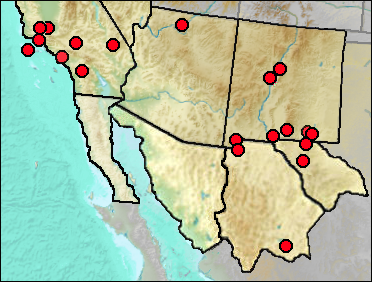
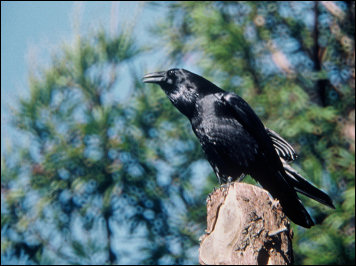 Common Ravens are plentiful in Late
Wisconsin sites. Re-examination of the few specimens from the Early or Early Mid Wisconsin sites
earlier (Magish and Harris 1976) assigned to C. corax indicate there is only one specimen,
1-1033 (see Fig. 1 in Corvus account) from Above Room of the Vanishing floor that can be
quite surely assigned to the species. Two of the other specimens are immature and appear likely to
be C. neomexicanus; the third specimen (UTEP 26-1651) is reassigned to C.
neomexicanus.
Common Ravens are plentiful in Late
Wisconsin sites. Re-examination of the few specimens from the Early or Early Mid Wisconsin sites
earlier (Magish and Harris 1976) assigned to C. corax indicate there is only one specimen,
1-1033 (see Fig. 1 in Corvus account) from Above Room of the Vanishing floor that can be
quite surely assigned to the species. Two of the other specimens are immature and appear likely to
be C. neomexicanus; the third specimen (UTEP 26-1651) is reassigned to C.
neomexicanus.
Fig. 1. Common Raven. US Fish & Wildlife Service, photograph by Lee Karney.
Magish and Harris (1976) found that the Dry Cave Late Wisconsin populations were intermediate in size between two modern subspecies, the larger, more northern C. corax principalis and the more southerly distributed C. c. sinuatus (see Fig. 1 of the Corvus account); the tarsometatarsus was relatively long, however, as in the southern subspecies. Many sites include immature birds, indicating nesting in the immediate vicinity.
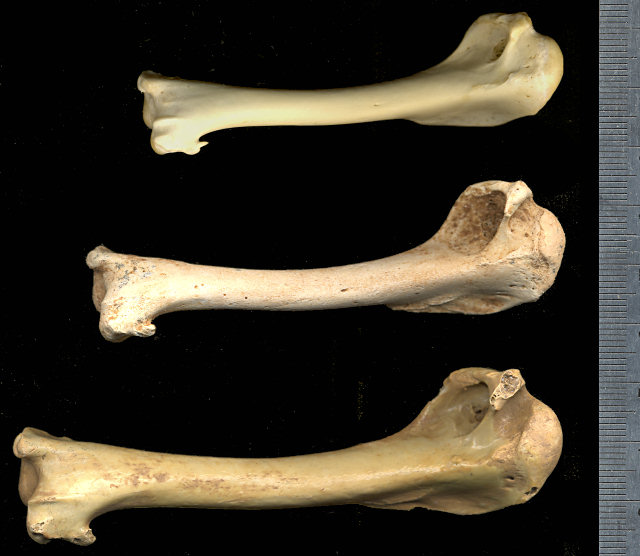
Fig. 2. Humeri of modern Corvus cryptoleucus (top, imaged reversed for comparison; UTEP 1030), fossil C. neomexicanus (middle, 27-227), and fossil C. corax (bottom, UTEP 23-67). Scale in mm.
Common Ravens are now widespread from piñon-juniper woodlands to high montane forest, but do not overlap extensively with the smaller Chihuahuan Raven (Corvus cryptoleucus), which generally is at lower elevations and limited to eastern and southern New Mexico and to the south.
The specimens from Mystery Light Cave include elements of two sizes. The larger specimens fit well with this species, but a carpometacarpus is very small for C. corax and falls within the size range of C. neomexicanus. I cannot assign it to that species without corroborative evidence and for present consider it as Corvus cf. corax.
Sites.
Rancholabrean/?Early Holocene: Mitchell Caverns (Jefferson 1991a).
Sangamon: Lincoln Ave. (Howard 1936).
Wisconsin: Carpinteria (Guthrie 2009); Zuma Creek (Jefferson 1991a).
Mid Wisconsin: McKittrick (Jefferson 1991a).
Mid Wisconsin-Holocene: Shelter Cave (Howard and Miller 1933).
Mid/Late Wisconsin: Dark Canyon Cave(Howard 1971); Diamond Valley (Springer et al. 2009); Hampton Court (Harris 1993c); NW Talus Slope (Harris 1993c); Pit N&W Animal Fair (Harris 1993c); Rancho La Brea (Stock and Harris 1992); San Miguel Island (Guthrie 1998).
Mid/Late Wisconsin/Holocene: Jimenez Cave (Messing 1986); Sierra Diablo Cave (UTEP).
Late Wisconsin: Animal Fair 18-20 ka (Harris 1989); Camel Room (Harris 1993c); Charlies Parlor (Harris 1989); Harris' Pocket (Harris 1989: cf.); Circus Route (Harris 1993c); Human Corridor (Harris 1993c); Maricopa (Jefferson 1991a); Mystery Light Cave (this volume); Pendejo Cave (Harris 2003); Sandia Cave (Brasso and Emslie 2006); Stalag 17 (Harris 1993c); TT II (Harris 1993c); U-Bar Cave 14-15 ka (Harris 1989).
Late Wisconsin/Holocene: Balcony Room (Harris 1993c); Conkling Cavern (Howard and Miller 1933); Howell's Ridge Cave (Howard 1962); Isleta Cave No. 1 (Harris 1993c); Isleta Cave No. 2 (Harris 1993c); Pendejo Cave (Harris 2003); Schuiling Cave (Jefferson 1991a); Stanton's Cave (Rea and Hargrave 1984).
Withdrawn Identification: Early/Early-Mid Wisconsin: Rm Vanishing Floor (Harris 1993c).
Literature. Brasso and Emslie 2006; Guthrie 1998, 2009; Harris 1989, 1993c, 2003; Howard 1936; Howard 1962, 1971; Howard and Miller 1933; Jefferson 1991a; Magish and Harris 1976; Messing 1986; Rea and Hargrave 1984; Springer et al. 2009; Stock and Harris 1992.
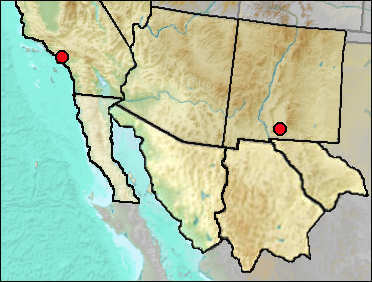
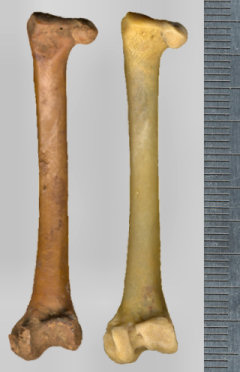 Chihuahuan Ravens are lowland birds, mostly limited to the Lower Sonoran Life Zone. The present distribution runs from southeastern Colorado and adjacent Oklahoma south to central Texas; eastern and the southern half of New Mexico is within the range as is southeastern Arizona; northern Mexico also is occupied. Thus the record from Rancho La Brea is a considerable distance northwest of the current range. The
only Pleistocene records from the eastern part of the region are from the Pendejo Cave late Wisconsin (11300-11900 BP, radiocarbon
years; Fig. 1) and Pendejo Cave mid Wisconsin (minimum age 30,210 BP, radiocarbon years; Fig.
2).
Chihuahuan Ravens are lowland birds, mostly limited to the Lower Sonoran Life Zone. The present distribution runs from southeastern Colorado and adjacent Oklahoma south to central Texas; eastern and the southern half of New Mexico is within the range as is southeastern Arizona; northern Mexico also is occupied. Thus the record from Rancho La Brea is a considerable distance northwest of the current range. The
only Pleistocene records from the eastern part of the region are from the Pendejo Cave late Wisconsin (11300-11900 BP, radiocarbon
years; Fig. 1) and Pendejo Cave mid Wisconsin (minimum age 30,210 BP, radiocarbon years; Fig.
2).
Fig. 1. Left femur of Corvus cryptoleucus (9366-G1347-337-1) from the late Wisconsin of Pendejo Cave compared to that of a modern specimen to its right. Metric scale.
The two specimens suggest that these ravens were excluded from the region during the colder portions of the Wisconsin, but that somewhat more benign conditions occurred locally in the mid Wisconsin and that after 12,000 BP, late Wisconsin conditions were approaching those of the Holocene.
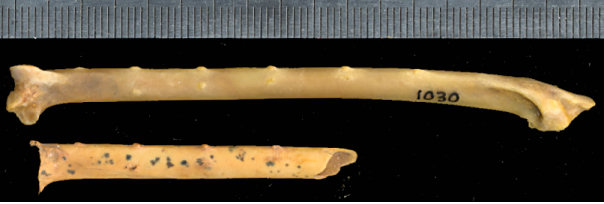
Fig. 2. Partial shaft of Corvus cryptoleucus ulna (9366-G1072-337-9) from the mid Wisconsin of Pendejo Cave compared to the same element of a modern specimen. Metric scale.
Sites.
Mid Wisconsin: Pendejo Cave (Harris 2003).
Mid/Late Wisconsin: Rancho La Brea (Stock and Harris 1992).
Late Wisconsin: Pendejo Cave (Harris 2003: as Late Wisconsin/Holocene).
Literature. Harris 2003; Stock and Harris 1992.
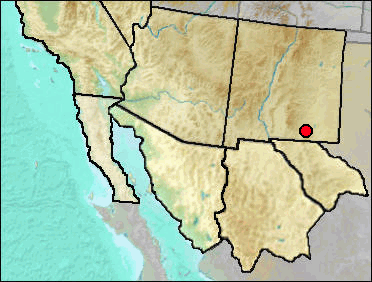
 This extinct raven is "intermediate in
size, but otherwise similar, to C. corax and C. cryptoleucus . . . ." (Magish
and Harris 1976:403). It is known only from the presumed Early or Early Mid Wisconsin of Dry Cave,
where it is abundant. Contrary to earlier reports (Harris 1993c), it now appears that the Common
Raven is represented by only a single element in these deposits. Presence of numerous immature
birds indicates nesting in or near the cave entrance.
This extinct raven is "intermediate in
size, but otherwise similar, to C. corax and C. cryptoleucus . . . ." (Magish
and Harris 1976:403). It is known only from the presumed Early or Early Mid Wisconsin of Dry Cave,
where it is abundant. Contrary to earlier reports (Harris 1993c), it now appears that the Common
Raven is represented by only a single element in these deposits. Presence of numerous immature
birds indicates nesting in or near the cave entrance.
Fig. 1. Tarsometatarsus of modern Corvus cryptoleucus (left, reversed; UTEP 1030), fossil C. neomexicanus (middle, UTEP 27-8), and fossil C. corax (right, reversed; 23-35).
Brodkorb (1978) tentatively considered the taxon as Corvus corax antecorax Mourer-Chauvire 1975, but without explanation or apparent justification. This is a European extinct raven, sometimes considered a species separate from C. corax.
Sites.
Early/Early-Mid Wisconsin: Lost Valley (Harris 1993c); Rm Vanishing Floor (Harris 1993c); Sabertooth Camel Maze (Harris 1993c).
Literature. Brodkorb 1978; Harris 1993c; Magish and Harris (1976).
Last Update: 26 Jun 2014